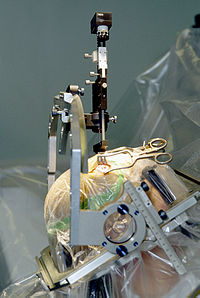
Photo from wikipedia
Almost all European countries lack contemporary skeletal collections for the development and validation of forensic anthropological methods. Furthermore, legal, ethical and practical considerations hinder the development of skeletal collections. A… Click to show full abstract
Almost all European countries lack contemporary skeletal collections for the development and validation of forensic anthropological methods. Furthermore, legal, ethical and practical considerations hinder the development of skeletal collections. A virtual skeletal database derived from clinical computed tomography (CT) scans provides a potential solution. However, clinical CT scans are typically generated with varying settings. This study investigates the effects of image segmentation and varying imaging conditions on the precision of virtual modelled pelves. An adult human cadaver was scanned using varying imaging conditions, such as scanner type and standard patient scanning protocol, slice thickness and exposure level. The pelvis was segmented from the various CT images resulting in virtually modelled pelves. The precision of the virtual modelling was determined per polygon mesh point. The fraction of mesh points resulting in point-to-point distance variations of 2 mm or less (95% confidence interval (CI)) was reported. Colour mapping was used to visualise modelling variability. At almost all (>97%) locations across the pelvis, the point-to-point distance variation is less than 2 mm (CI = 95%). In >91% of the locations, the point-to-point distance variation was less than 1 mm (CI = 95%). This indicates that the geometric variability of the virtual pelvis as a result of segmentation and imaging conditions rarely exceeds the generally accepted linear error of 2 mm. Colour mapping shows that areas with large variability are predominantly joint surfaces. Therefore, results indicate that segmented bone elements from patient-derived CT scans are a sufficiently precise source for creating a virtual skeletal database.
Journal Title: International Journal of Legal Medicine
Year Published: 2017
Link to full text (if available)
Share on Social Media: Sign Up to like & get
recommendations!